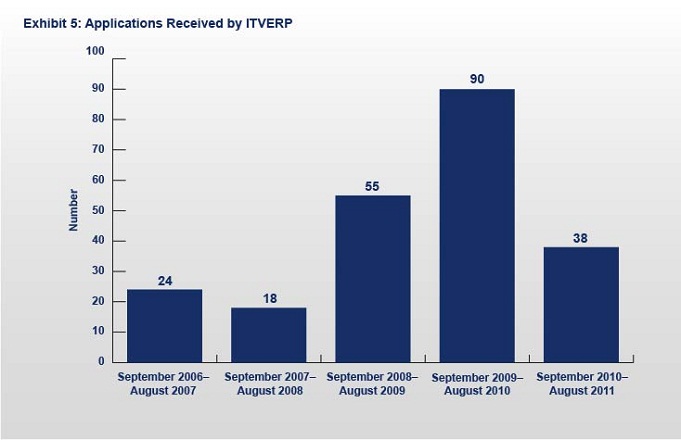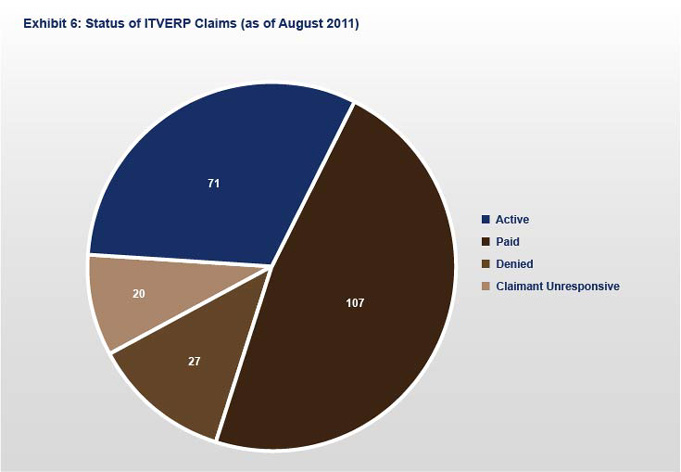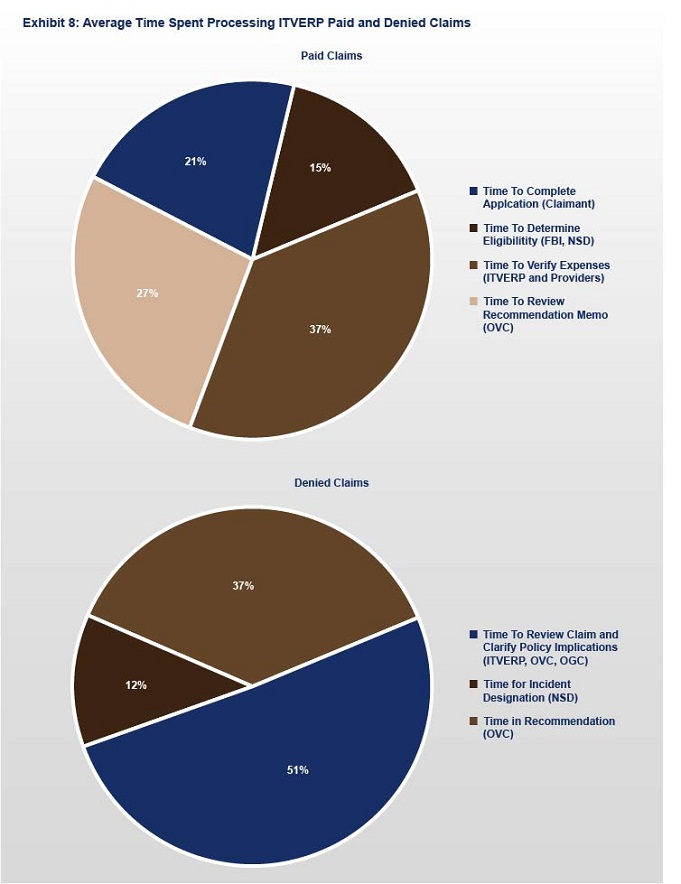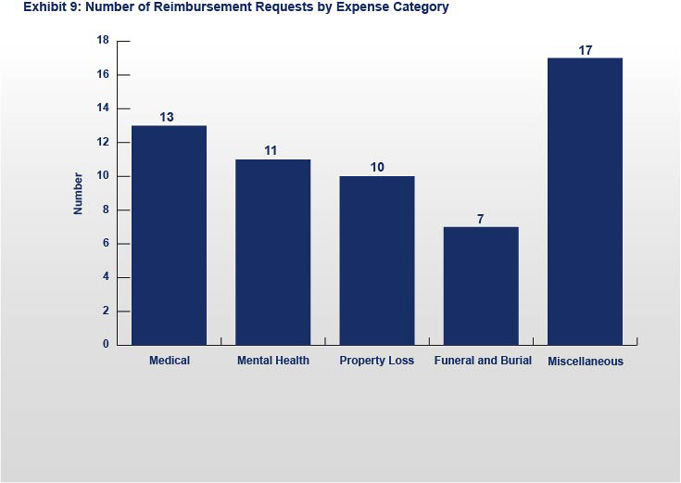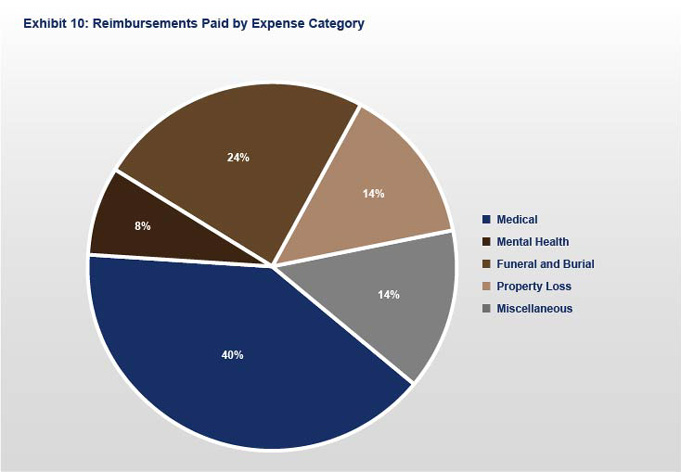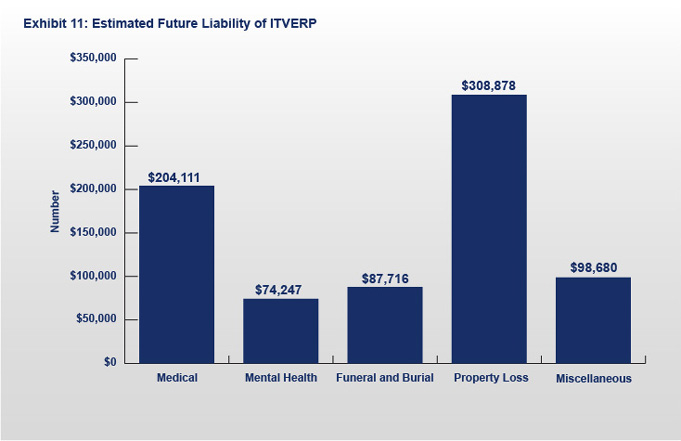ITVERP Assistance and Outreach
This report provides a summary of the International Terrorism Victim Expense Reimbursement Program’s (ITVERP) activities during the September 2010 through August 2011 reporting period. It covers two main areas of ITVERP assistance—application processing and claims payment, and public awareness activities undertaken to reach out to potential claimants. A discussion of future program needs and improvements is included at the end of the report.
Reimbursement Activities
This section highlights the activities and accomplishments related to ITVERP’s main function of processing applications for reimbursement, including—
- The number of applications received;
- The status of claims;
- The current processing time for claims;
- Details regarding reimbursements paid to claimants; and
- The number of appeals under the program to date.
Applications Received and Processed
During this reporting period, ITVERP received 38 new applications for reimbursement. The applications reflect terrorist incidents dating from June 14, 1985, to December 18, 2010. Exhibit 5 illustrates the number of applications received during each ITVERP reporting period since the program’s inception in 2006.
Status of Claims
As claims reach certain phases in the application process, OVC assigns them one of four related statuses. Claims may be in process for several weeks while eligibility and expenses are verified, additional information is requested, etc. Frequently, claimants initiate the application process but do not provide complete information. Claimants have 120 calendar days from the time ITVERP receives their initial application to provide the necessary information or the claim will become inactive. A claim is considered paid after a claimant receives payment. A claim is considered inactive if the claim is denied.
At the end of this reporting period, there were 71 active claims, of which 59 claims were in process, 6 claims were pending National Security Division (NSD) designation, and 6 claims were partially paid. ITVERP has paid 107 claims, denied 27 claims, and designated 7 claims inactive/unresponsive. Exhibit 6 presents the status of all ITVERP claims.
Processing Time
Processing ITVERP claims requires verification of claimant eligibility and that the expenses submitted are processed in compliance with ITVERP regulations. Denied claims typically require less time to process because ITVERP does not have to wait for the application to be completed by the claimant or for expenses to be verified in order to determine the applicant’s eligibility. Exhibit 7 shows the average length of time it took to process the 107 paid claims and the 27 denied claims completed at the end of this reporting period.
Exhibit 8 shows the percentage of time spent on different steps in the claims process, broken down by paid and denied claims.
Reimbursement Requests by Expense Categories
Potential claimants who have incurred multiple expenses as a result of their victimization may apply for reimbursement in more than one expense category. ITVERP case managers work closely with claimants and potential claimants to assess and fully identify their needs to ensure they receive the maximum reimbursement allowable. Exhibit 9 shows the number of reimbursements requested, by category, during this reporting period; many claimants applied for reimbursement under multiple expense categories.
Reimbursements Paid by Expense Categories
To date, ITVERP paid 107 requests for reimbursement and made 6 partial payments. Those payments totaled $1,117,164.47. Exhibit 10 shows the percentage of reimbursements paid out by each expense category during the reporting period; many claimants applied for reimbursement under multiple expense categories.
Appeals
Under ITVERP regulations, claimants may file an appeal within 30 days of receipt of a final determination of their claim. During this reporting period, no official appeals were filed.
Future Liability
In process claims represent an estimate of ITVERP’s future liability. If all in process claims are paid at the amounts requested, including the remaining balances on partial payments, ITVERP’s future liability is $773,632.00. Exhibit 11 shows ITVERP’s estimated future liability by type of reimbursement.
Promoting Public Awareness
Victims of terrorism must focus on the immediate medical, mental health, family, housing, and other needs for themselves and their loved ones. Many victims and their families are not aware of resources available to them. A critical component of ITVERP includes ongoing outreach to inform victims of international terrorist incidents and their families of the assistance this program offers. Outreach activities are focused on two primary groups: potential claimants, and collaborating agencies and organizations that may have contact with potential claimants. This section details the outreach efforts that took place during this reporting period and provides information on the ITVERP Resource Center.
Outreach to Potential Claimants
ITVERP outreach efforts focus on victims of international acts of terrorism and their family members who may be eligible for reimbursement under the program. OVC coordinates with the Office for Victim Assistance (OVA) in the Federal Office of Investigation (FBI) and the U.S. Department of State (DOS) to identify potential claimants. When terrorist incidents occur outside the United States and involve U.S. citizens, DOS is the first to respond, locating and identifying the victims. DOS coordinates and communicates with OVA, which provides immediate and ongoing victim assistance support to victims and their families. Where appropriate, OVA identifies ITVERP as a potential resource and provides victims or their family members with program information. For the victims and family members who choose to apply, ITVERP determines eligibility.
Interagency coordination enhances ITVERP’s outreach efforts and gives potential claimants access to needed resources. During this reporting period, OVC, OVA, and DOS coordinated efforts to identify and reach out to 298 potential claimants. With materials provided by OVC, OVA was able to disseminate ITVERP information in the immediate aftermath of a terrorist incident in Frankfurt, Germany, on March 2, 2011.
Outreach to Collaborating Agencies and Organizations
Another goal of OVC’s outreach efforts is to educate the victim assistance community, including collaborating agencies and potential partners, about ITVERP. By reaching out to national and international organizations, and individuals that may come into contact with victims of international terrorism, OVC increases awareness about ITVERP and the resources available.
A change to the ITVERP regulation, effective April 11, 2011, allowed the OVC Director discretion in extending the filing of ITVERP applications under certain circumstances. During this reporting period, OVC coordinated with the victim witness coordinator in the U.S. Attorney’s Office in the Southern District of New York in an effort to expand outreach efforts to victims of international terrorist attacks involved in U.S. federal court cases that may not be aware of the program. In August 2011, OVC identified methods of conducting targeted outreach to entities such as the Peace Corps, universities that facilitate study abroad programs, U.S. contractors and companies working abroad, Embassies, and various conferences in which OVC regularly participates.
ITVERP Resource Center
The ITVERP Resource Center responds to questions and requests made through its dedicated toll free hotline and e-mail address. Program staff are available to respond to inquiries Monday through Friday between the hours of 8:30 a.m. and 5:30 p.m. eastern time. Federal, state, and local government agency staff contact the Resource Center to obtain information regarding the program’s rules and eligibility on behalf of specific victims, and to provide information about potential claimants and particular terrorist incidents that might qualify for ITVERP reimbursement. Similarly, nongovernmental organizations contact the ITVERP Resource Center to obtain information about the program to include in their own outreach efforts.
All congressional inquiries received by OVC are promptly directed to OJP’s Office of Communications. During the reporting period, OVC received no written inquiries from congressional offices requesting information on specific ITVERP claims submitted by their constituents.
ITVERP Online
Claimants and potential applicants can obtain information about the program, including eligibility criteria, reimbursable expenses, and instructions for filing an application, through the ITVERP Web page. Potential claimants can download the application for reimbursement, checklists, and supporting documents directly from the site, which also provides a list of answers to frequently asked questions to assist with the application process. During the reporting period, OVC enhanced the page to include an updated list of NSD-designated terrorist incidents.
Future Program Needs and Improvements
While there have been important achievements since ITVERP began, we must ensure that resources continue to be readily and easily accessible to victims and their families. During this past year, OVC learned valuable information that will guide future enhancements to ITVERP.
Enhancing customer service and communication with claimants continues to be a program priority. OVC will continue to focus on customer service, including reviewing the ITVERP claim process and improving staff communication with victims and families applying for reimbursement. Additionally, OVC recognizes the importance of collaborating with other agencies and organizations and will continue to expand its partnership network.
As ITVERP continues to assist victims and their families in the aftermath of international terrorist incidents, OVC will refine and enhance its outreach and customer service efforts. In the coming year, OVC will focus on augmenting several program areas, including outreach efforts to victims of terrorist incidents occurring outside the United States, coordination with state compensation programs, and coordination with other federal agencies and organizations.


